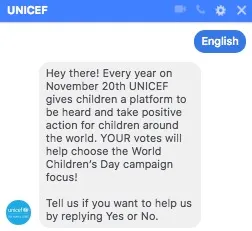
Everyone wants awesome engagement and customer experience, but as you probably know by now, it takes the right combination of marketing strategy and product value to realize these two goals. Chatbots, as voice or text-based messaging experience, really do engage better and offer a unique opportunity for lead building, responsiveness, efficiency and experience unlike any other medium.You might be confused by the naysayer, spouting loudly how chatbots are, well, over. The reality is, chatbots are the start of an immerging new space, where automated and AI-based messaging will stand to revolutionize customer experience and how brands engage.Not sure you trust that sentiment? Instead, here's an inside look at how chatbot example across messaging channels really led to fantastic visitor engagement and other promising metrics.Read on to see how you can begin to use automated messaging and conversational AI to strengthen your engagement numbers.
UNICEF Survey Chatbot

UNICEF and nativeMsg worked together to create a chatbot for Facebook Messenger and as a web app.The Goal: Engender global community awareness and weigh-in on the top issues facing children globally.Execution: nativeMsg was asked to render a chatbot experience as a survey. The survey was meant to drive awareness for issues facing children for UNICEF's annual Global Children's Day in November.First, to create true global accessibility, the survey chatbot needed to be designed in several languages and deployed on a platform that was accessible and popular on many continents. The non-profit ultimately opted for deployment on a web app and Facebook in four languages: French, English, Spanish and Arabic.Next, UNICEF wisely chose to keep the focus on a few of the most prevailing topics facing chilren's issues worldwide, thereby keeping the chatbot's rails secured to a simplified, clear goal.The design allowed visitors to begin by choosing what language they wanted to engage in. Then, they could opt out of the survey altogether. Finally, they were given a choice of prospective focuses for UNICEF's Global Children's Day. Effectively, users would decide the most pressing issues facing children globally today.

nativeMsg used a combination of rule-based and AI-automated design flows in these two channels for a simple, pain-free survey experience that took less than 30 seconds to complete.The Results:The campaign results hovered around a 70% completion rate. The survey bot generated almost 128,000 messages and over 11,000 participants engaged with it. The chatbot survey ran for a week.
In a one-week campaign, the survey bot generated almost 128,000 messages and over 11,000 participants engaged with it.
The average email survey response rate lies around 25%, while telephone response rates lie between 8-12%. The chatbot survey resulted in a strong response rate, higher than the average rate, which lies between 10-15%.External surveys tend toward less responsiveness. But an easy to use interface, like the chatbot launched for UNICEF, is a good entry point for any engagement strategy.Strategy: First, Facebook as a social channel choice, is still the dominant social site nationally, with 79% of those with internet engaged on it. It's also a predominant B2C social site. For B2C businesses, like retail or the hospitality industry, targeting Facebook is a reliable strategy for higher engagement.
For B2C businesses, like retail or the hospitality industry, targeting Facebook is a reliable strategy for higher engagement.
Per SurveyGizmo, short, to the point surveys work better. Chatbots not only speed up the process, but also provide increased user control. It's much easier to scroll back to a question in a conversation thread or opt out of the conversation when you want to with a conversational UI than it is with a multi-screen emailed approach or telephone survey. UNICEF offered users a fast and direct route to taking part in a meaningful campaign.Any chatbot experience must be personally relevant to compel a user to interact. The best goals should be high-level and top of funnel at first. Everything from answering general questions, in a 24/7 space, to product Q&As to help inform a consumer's purchase decision are great goals for a chatbot as a first-line customer service rep.
Chatbots Create Increased Time on Page
Likewise, nativeMsg's experience in chatbot development shows high time-on-page metrics; that's true for even the more modest deployment, where one garnered 1:44 minutes for time in the conversation. Traditional websites first user scans are 10 to 20 seconds, per Hubspot, and a 40-50 second time on page is considered decent. This number showed that users were staying on much longer upon a first visit.Return visits, even for a modest bot, have garnered 20% repeat users––without huge promotion or traffic.
Return visits, even for a modest bot, have garnered 20% repeat users––without huge promotion or traffic.
How to Replicate:
First, the very nature of conversational AI is that it's novel, so it's going to garner more interactivity. But you don't have to design an extraordinarily complex bot to create high levels of engagement. You can harness these healthy engagement numbers and promising metrics by taking these steps:
- Determine Where Your Customers Engage Most!-That's an easy step. You know where you focus most of your customer service, so why not place a chatbot there?
- Keep the Focus on ONE Main Customer Pain Point-Your customers just want the fastest route to the right answer. Review one of the weakest areas of your customer service footprint and create the chatbot toward it: Simplify the refund process, simplify the order status process, simplify the appointment process- you get the idea.
- Stay Committed to Iteration and Conversation Management-Great conversational UIs are managed, updated and nurtured. Keep an eye on where bounce rates occur within the conversation and continue to tweak it.
To schedule a demo to see how your business can integrate conversational UI into your customer service strategy, make an appointment here.

